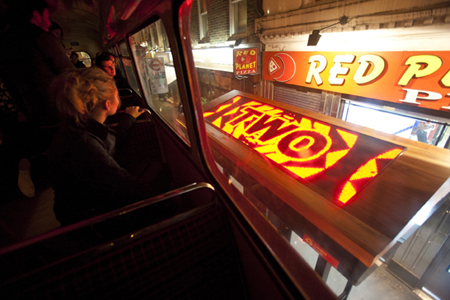The following is an essay for the newspaper distributed to participants of Edgelands, a one-day ‘flash conference’ on technology and the arts, held in Edinburgh on 21st August 2011.
Hannah asked me to write something about technology for the arts sector, and I chose a slightly different take on the notion of ‘Technology as a Material’. I’ve written about material exploration of data before. This piece was intended as a broader, more high-level exploration of the topic for creators in the arts.
Much of the thinking in here – although shaped by my own experiences – began during my time at Berg, and I specifically wanted to thank my former colleagues for their many investigations into “Immaterials” and their undeniable influence on this train of thought.
Video: Immaterials: The Ghost In The Field by Timo Arnall, Jack Schulze and Einar Sneve Martinussen.
To make art with technology, one does not use it as a tool; one must understand it as a material. Technology is not always a tool, an engineering substrate; it can be something to mould, to shape, to sculpt with.
Materials have desires, affordances, and textures; they have grains. We can work with that grain, understanding what the material wishes to be, wishes to do – or we can deliberately choose to work against it. We must understand that grain and make a deliberate choice.
Software is a material. A language like Processing is better at some tasks than others, faster at some things than others, easier to manipulate in certain directions and harder in others. It has a grain, and desires, that we must understand to work with it – that we learn through working with it.
A service like Twitter has an inherent pace, a vernacular language, limitations on its functionality. A project built with it needs to work within these givens to be suited to the medium.
Data is a material. To work with streams of live information, or data sources from an API, it to understand the fidelity of that information, the frequency of update, the relations to other data it affords or not. To work with it requires exploring the dataset, honing your demands of it to those it can meet.
Hardware is a material. As Anthony Dunne writes in Hertzian Tales: “All electronic products are hybrids of radiation and matter“. To build with electronics is to understand both that radiation and that matter. How fragile is the hardware? How can it be housed? Is the output from sensors like cameras or microphones accurate enough? And in the case of radio-based hardware, be it GPS, 3G, Bluetooth or RFID – what affects the field of that radio? Is it useful to the fidelity you require? Is it an appropriate solution for the installation? How does it even work?
In “Immaterials: The Ghost in the Field”, Timo Arnall, Jack Schulze and Einar Sneve Martinussen explore the spatial qualities of RFID through long-exposure photography and an LED probe. The end result is an actual understanding of the field of an RFID reader, not read on a datasheet, but gleaned through experimentation and exploration – all to better understand RFID as a material in its own right.
We understand materials not by reading about them, or assuming what they can do, but by exploring them, playing with them, sketching with them. Ideally, that sketching happens in the final material, but perhaps, like a sculptor sketching on paper, it happens in abstractions such as paper-prototyping. What matters is that you find a way. Sketching is not just about building towards a final work; it’s about building familiarity with a medium itself, working it into one’s practice.
As creators, we must feel our materials – even if we are not the ones using them in the end.
The sculpture analogy is again useful. For centuries, sculptors have worked with the aid of others in their studios and workshops, to produce large works. But despite drawing on the expertise of others, they must be skilled in their chosen mediums themselves.
Last year, I went to see an exhibition of sculptor Rachel Whiteread’s notebooks. In amongst the sketches and prototypes, there was a piece of circular graph paper with a line traced on it. This was part of the process of Monument, Whiteread’s resin, mirrored cast of the fourth plinth in Trafalgar square. It was a print-out from a machine used to test the resin Whiteread was using to cast the sculpture. There, inside her notebook, she had kept a proof of the material’s capacities: a commitment to understanding the material she’d be working with. If technology is a material, artists should treat it no differently.
A better understanding of materials leads to better usage of them. Poor execution cannot be written off with the excuse “oh, but it’s art“; the vernacular understanding of technology is now too sophisticated for that. To embrace an audience’s existing understanding of technology, we must meet their expectations: not being ugly, not being broken. Audiences expect polish, even in experimental work. And to understand that execution, we must become literate in our materials.
Alan Kay defined literacy as “the ability to both read and write in a medium“. I would agree – but I must also be honest: the barrier to becoming literate with technology is perhaps higher than for those materials you can feel in your bare hands.
It’s still lower than it ever has been, though. Compare the diversity and quality of tools aimed at the non-specialist, the designer, the creative to what was availably twenty, thirty years ago. It’s not just that technology has advanced: our abstractions have too. Thanks to prototyping and creative tools such as Max/MSP, OpenFrameworks, or Arduino, it is easier than ever to explore the creative applications of technology.
And, as throughout the arts, there is always value in collaboration. To make art with technology is to make art with technologists, and there are a great many people out there – if you look for them – sensitive to creative endeavours, skilled in technology, and eager to collaborate.
It’s imperative to work with technologists through the creative process: they are not just manufacturers, but collaborators. As a technologist, it’s important for me to observe the terrain I’m working in, to sit with others and see them at work, for them to see what my process looks like. It’s how we come to a shared understanding of one another, and of the work itself.
Technology is not something to be used cynically, to qualify for funding, or to add a veneer of supposed “innovation” to tired work. For art is a purpose, not an excuse. To make art with technology is to make art out of technology. Artists should consider it as a material like any other.



